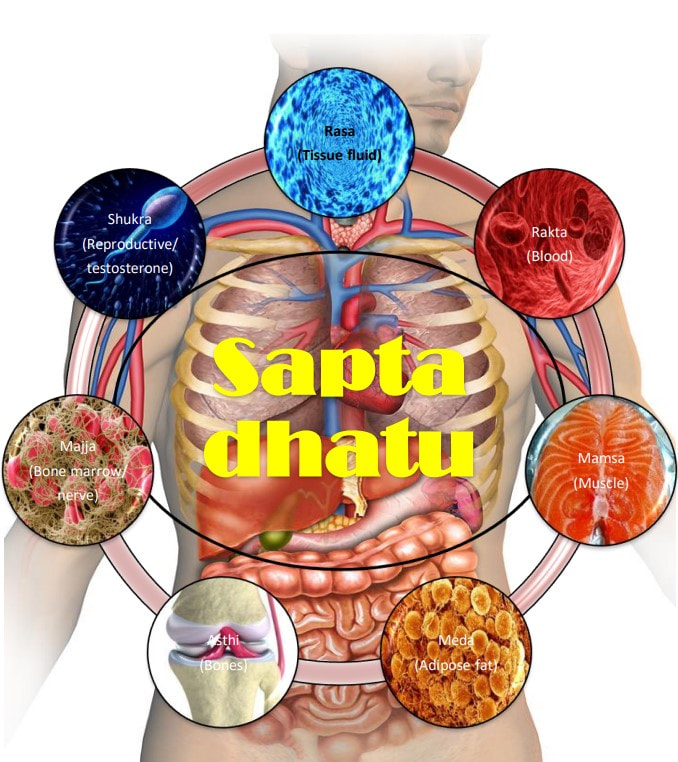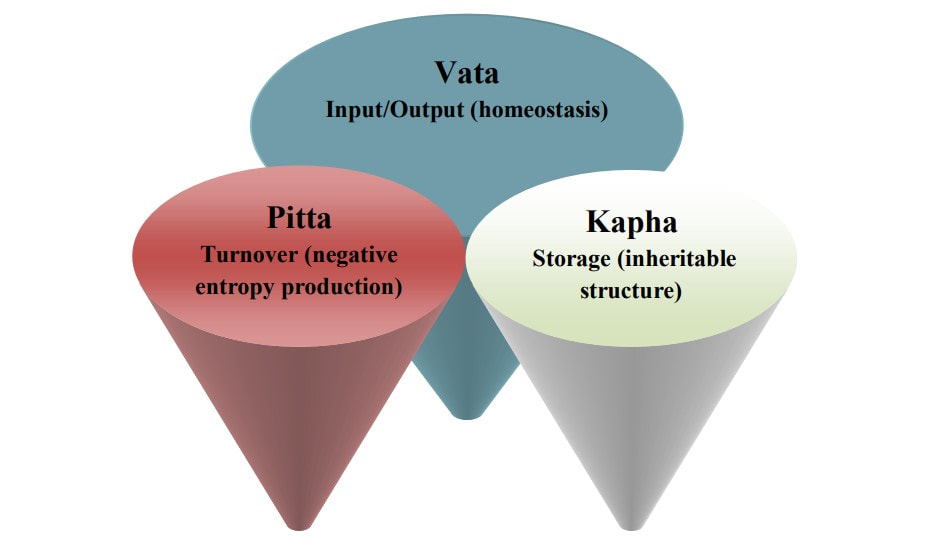Basic concept of Ayurveda:
“Ayurveda” the word comes from the Sanskrit terms Ayur (life) and Veda (knowledge), is the ancient medical science prevalent for thousands of years in the Indian subcontinent. Ayurveda believes that the entire universe is composed of five elements: Vayu (Air), Jala (Water), Aakash (Space or ether), Prithvi (Earth) and Teja (Fire). These five elements (referred to as Pancha Mahabhoota in Ayurveda) are believed to form the Tridosha i.e the three basic humors of human body in varying combinations. The three humors; Vata dosha, Pitta dosha and Kapha dosha are collectively called as “Tridoshas” and they control the basic physiological functions of the body along with five sub-doshas for each of the principal doshas. According to ancient scholars of Ayurveda the human body consists of Saptadhatus (seven tissues) Rasa (tissue fluids), Meda (fat and connective tissue), Rakta (blood), Asthi (bones), Majja (marrow), Mamsa (muscle), and Shukra (semen) and three Malas (waste products) of the body, viz. Purisha (faeces), Mutra (urine) and Sweda (sweat). These seven tissues work in coordination with each for proper physiological functioning of the human body. The Rakta Dhatu resembles the blood and regulates the circulation of blood cells and provision of blood components to the body. The Mamsa Dhatu (Muscle tissue) provides supports in the form of skeletal muscles for the Meda Dhatu (adipose fat). The Asthi Dhatu comprises the bones of the body and the Majja Dhatu is made up of the bone marrow and fluids required for the oleation of the bones and their functioning. The Shukra Dhatu is responsible for functions of the reproductive organs of the body
- Vata dosha: Maintains the cellular transport, electrolyte balance, elimination of waste products and its effect is increased by dryness.
- Pitta dosha: Regulates the body temperature, optic nerve coordination and hunger and thirst management. Heat conditions of the body aggravate Pitta.
- Kapha dosha: It is increased due to sweet and fatty food and it provides lubrication to the joints for proper functioning
The catabolism of the body is believed to be governed by Vata, metabolism by Pitta and anabolism by Kapha. For a healthy state of health, a balance between the three doshas and other factors should be maintained. Any imbalance between the three causes a state of illness or disease. Apart from the Doshas and the Dhatus, the other important factors considered in the doctrine of Ayurveda are the Tri Malas and Trayo Dosa Agni. Tri Malas are the three types of waste products formed in the body due to metabolic and digestive functions of the body. They comprise of the Mutra (urine), Purisa (faeces), and Sveda (sweat). Ayurveda explains that if the balance between Tridosha is not maintained the waste products of the body are not effectively eliminated and these lead to further complications like diarrhea,
constipation, asthma, rheumatoid arthritis and such other complications. If the Mutra Mala
(urine) is not removed from the body, it can lead to urinary tract infections, cystitis and gastric pain. If the Sveda Mala is not cleared from the body, it can lead to skin irritation problems, and improper fluid balance. As per the principles of Ayurveda the biological fire of the body for all the metabolic function is called as “Agni”. There are thirteen categories of Agni in a human body and the most important is the one responsible for digestive fire, called as Jatharagni. Jatharagni has a close relation with Pitta and ultimately Vatta of the body. If the digestive fire of the body is increased in the body by increase in acidity conditions, the elevation in Pitta levels and its relative symptoms are observed. Digestive fire is important in controlling the normal microflora, proper digestive functions and provision of energy to the entire body. Any disturbances in its balance, creates discomfort to the gastro-intestinal tract and results in pathological complications like ulcers, diarrhea and constipation

Brief about Tridosha Concept:
In traditional Ayurveda, basic concepts such as Tridosha are instigated didactically. This concept of tridosha involving the three doshas of vata, pitta, and kapha is a central doctrine of Ayurveda and follows from the first chapter of the earliest text on Ayurveda, the Charaka Samhita[5]. In Ayurveda the concept of tridosha theory is originated from the theory of the three elements of the universe. The names of these three doshas, which are roughly equivalent to humour, are Vata (wind), Pitta (bile), and Kapha (phlegm), are corresponding to the three elements of the universe: air, fire, and water. The process of the formation of the Tridosha theory is considered as -“Earth” was segregated from the four elements of the universe owing to its solid properties, and was rearranged into the seven elements of the body called “Dhatu”; and the other three elements. “water”, “fire”, and “air”, were integrated as the
tridosha theory, namely, the theory of the three humours, owing to their properties of fluid; In Ayurveda fundamental concepts – the three Doshas, their fifteen subdoshas, innate Dosha balance in the individual (Prakriti), and Dosha imbalances (Vikriti) are scientifically valid. Many researchers have already shows- how Tridosha applies to every living organism from the first cells, and how it is inherited and diversified in the history of life[6]. The study on Ayugenomics confirms Dosha’s inheritance. Each Dosha is responsible for regulating an essential aspect of organism function, connected to a recognized definition of life:

Brief about concept of Prakriti:
This is another core concept of traditional Ayurveda, allow implementation of ways for not only personalized medicine and treatment but also personalized prevention. In the light of modern or current science, evidence has shelled concerning the concepts of Tridosha and Prakriti with metabolic pathways, chronic diseases, and various genotypes which may enable the prevention of various chronic diseases via the implementation of various dietary, lifestyle, and habitual changes. Prakriti is believed to be determined at the time of conception and remain unaltered during the lifetime with contributions from environmental factors including maternal diet and lifestyle.[7] Based on the predominance of individual doshas, there are three major types of Prakriti named after predominant dosha, viz., Vata, Pitta and Kapha. These Prakritis exhibit attributes of the dominant Dosha in physical, physiological
and psychological characteristics. Every individual can be categorized into various combinations of Vata, Pitta, and Kapha Prakriti depending upon the predominance of each Dosha and is independent of race, ethnicity, language, and geography, which will be specific for each individual. The susceptibility to different diseases depends upon the type of Prakriti (constitution) in an individual. Therefore, assessment of Prakriti is not only helping in understanding the physical and mental constitution of patient, but also plays a vital role in prognosis, diagnosis, treatment, and prevention of many complex diseases. Vata, pitta, and Kapha Prakriti are found to have unique metabolic activities. According to Ayurveda, Kapha is slow, Pitta is fast, and Vata is considered to have variable metabolism. The disturbance in equilibrium of these Doshas can lead to disease according to the Prakriti of the person for example; a Pitta Prakriti person is described to be more prone to peptic ulcers, hypertension, and skin diseases, a Vata prakriti person to backache, joint aches and crackling joints while individuals with Kapha prakriti are prone to obesity, diabetes and atherosclerosis[7-11]. Studies involving subjects of various Prakriti types viz. Vata, Pitta and Kapha, were carried out to identify molecular differences that affect susceptibility and responses of individuals to various environmental or disease conditions. A classification method for human population, with respect to DNA methylation signatures is reported based upon traditional Ayurveda concept of Prakriti. In a recent study it was suggested that the peptide coenzyme A, which occurs in all cells across all species-preserved through evolution and is associated with lipid metabolism, is linked with the Tridoshas at the cellular level.[12] This implementation of preventive practices from an early age may result in such children leading healthy, disease-free, more productive lives. Thus, eventually, this can be an opportunity to practice personalized preventive health, which is not a possibility in other systems of medicine especially western systems of medicine. Personalized preventive health is one step further than personalized medicine and is a very novel idea with far-reaching implications[13,14]
Treatment Principle of Ayurveda:
Ayurveda always emphasize to improve general health with a deeper intent to prevent sickness rather than management of an ailment. According to Acharya Sushruta-“When there is a balance of Dosha (Vata, Pitaa and Kapha), Agni (digestive fire), Dhatu (plasma, blood etc seven tissues) and their coordination it helps in elimination of Mala (waste matter) regularly. This process keeps our soul, mind & sense organs in balance. In Ayurveda this state is termed as Swatha (healthy state).” Acharya Charaka classified Chikitsa (treatment) into three types –
- Daivavyapashraya Chikitsa (Divine Therapy): This is a nonpharmacological treatment based on based on faith in divine power and social rituals. E.g. mantra chanting and mala japa etc ritual customs.
- Satvavajaya Chikitsa (Psychotherapy): It is a psycho-behavioral Ayurveda therapy applied mainly in mental illness and a few physical diseases where it is a supportive therapy. The classical Sattavajaya is based on Substitution of emotions, Commitment and Psychotherapy.
- Yuktivyapashraya Chikitsa (Rational Therapy): i.e. pharmacological management which is branched into two wings namely; shodhana chikitsa (detoxification therapy) and shaman chikitsa (curative therapy). Shaman therapy includes deepan (appetizer), pachana (digestive) etc. and shodhana therapy includes panchakarma that is a set of five therapies delineate mainly for cleansing the body toxins to achieve balanced state of body that facilitates rejuvenation.